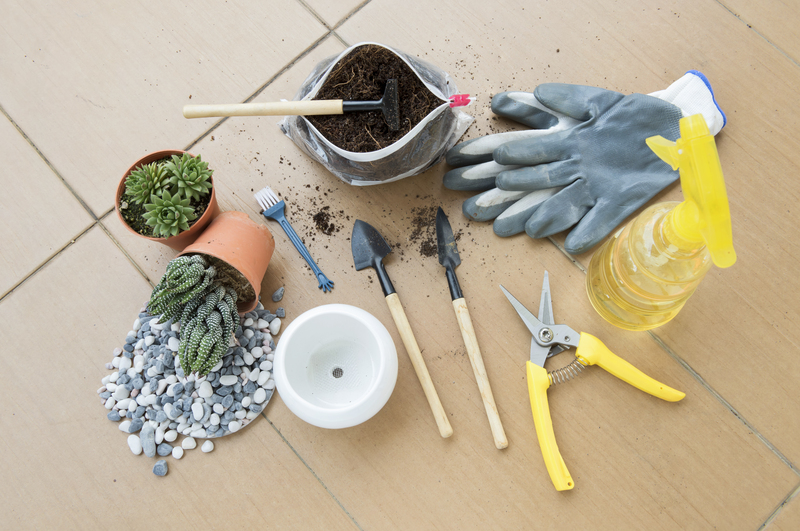Design Ideas for a Garden that is Both Fun and Secure for Kids
Posted on 11/06/2025
Design Ideas for a Garden that is Both Fun and Secure for Kids
When it comes to crafting the perfect outdoor space, parents and guardians must balance two vital elements: fun and safety. A garden should be a place of joy, discovery, and adventure for children, but it must also prioritize their well-being. In this article, we'll explore comprehensive, creative, and practical garden design ideas that are both entertaining and secure for kids. Whether you're starting afresh or revamping a current space, these insights will help you create an outdoor haven tailored to your family's needs.
Understanding the Importance of a Child-Friendly and Safe Garden
Before delving into the design aspects, it's crucial to grasp why a secure and fun garden is essential for kids. Outdoor play:
- Boosts physical health and motor skills through active movement.
- Encourages creativity via unstructured play.
- Supports emotional and social development, especially during group play.
- Connects children to nature, fostering lifelong appreciation and environmental awareness.
However, outdoor spaces come with certain risks. This is why designing a fun and kid-safe garden should address both enjoyment and protection.

Key Principles for Designing a Garden That's Fun and Safe for Children
Thorough Risk Assessment
Start by evaluating your existing outdoor area. Identify potential hazards like open water features, sharp stones, poisonous plants, or unfenced areas. Understanding these risks helps in creating a secure garden environment for kids.
Visibility and Supervision
A garden layout favoring open sight lines allows adults to supervise children as they play. Position play zones where you can see them from the house or patio. Avoid tall, dense shrubberies that could create blind spots.
Age-Appropriate Spaces
Design your child-friendly garden according to the age and abilities of your kids. For toddlers, prioritize soft surfaces and contain areas. For older children, integrate challenging elements while maintaining safety.
Innovative and Safe Play Features for the Garden
1. Safe Play Zones
Designate specific areas for different activities to prevent overcrowding and collisions. Ideas include:
- Sandpits with Covers: Use a sandpit with a secure lid to keep out debris and animals.
- Soft Play Lawns: Natural grass or artificial turf provides a cushioned area for running and tumbling.
- Picnic Areas: Create spots for snack breaks, art projects, or quiet reading.
2. Climbing and Adventure Structures
Foster physical growth and problem-solving with safe climbing apparatus:
- Low Wooden Climbing Frames (checked for splinters and securely anchored)
- Log Balancing Beams
- Sturdy Swings and Slides with shock-absorbing surfaces below
Tip: Always follow manufacturer's guidelines for installation and routine inspection.
3. Natural Play Elements
Encourage eco-friendly fun by integrating the landscape into your garden's play features:
- Tree Stump Stepping Stones: Sand and seal surfaces to avoid splinters.
- Hollow Logs: Great for hide-and-seek and bug-spotting.
- Willow Dens or Teepees: Living structures formed from willow or bamboo canes--perfect for imaginative play and a touch of magic.
4. Sensory Gardens
Children love gardens that engage all five senses! Plant fragrant herbs (like lavender and mint) along pathways, add textured plants (such as Lamb's Ear), and include wind chimes or water features that engage hearing. For taste, provide patches of edible plants (more on this below).
Planting for Safety and Fun
Choosing Non-Toxic, Child-Safe Plants
One of the most vital steps in creating a secure garden for kids is plant selection. Avoid species known to be toxic, such as foxglove, oleander, yew, and lily of the valley. Instead, opt for non-toxic plants that encourage exploration and interaction, such as:
- Sunflowers
- Marigolds
- Snapdragons
- Sweet peas (avoid the seeds)
- Chives, mint, basil, and other herbs
Pro tip: Involve your children in sowing and tending these plants to nurture curiosity and responsibility.
Edible Gardens: Fun and Tasty Learning
Planting a mini-vegetable patch serves both educational and culinary purposes. Easy crops include:
- Cherry tomatoes
- Strawberries
- Radishes
- Peas and beans (with climbing frames)
Label each plant and let your kids help with watering and picking. They'll learn about food origins while enjoying the rewards of their labor!
Essential Safety Measures for Gardens with Kids
Fencing and Boundaries
Proper fencing is non-negotiable for a secure and fun garden:
- Choose fences at least 1.2 meters (4 feet) high for younger kids.
- Ensure gates are self-closing and latched out of children's reach.
- Opt for solid panel or closely spaced picket fences to prevent squeezing through.
If you have water (ponds, fountains), install sturdy covers or mesh guards to block access.
Safe Surfaces for Active Play
Falls are inevitable, but injuries aren't. Use impact-absorbing surfaces like:
- Bark chips or wood mulch
- Rubber play tiles
- Well-maintained grass
Avoid concrete, gravel, and flagstones where children play vigorously.
Tool and Chemical Storage
All gardening tools, chemicals, and fertilizers should be:
- Stored in locked or childproofed sheds or cabinets
- Never left out unattended
- Regularly checked for rust or sharp points
Pet and Wildlife Considerations
If you have pets or attract wildlife, ensure animal areas are separated from children's play zones. Replace open compost bins with secure tumblers and avoid berry plants that could be poisonous to children or animals.
Adding Creative Fun Elements That Are Also Safe
1. Discovery Paths
Lay out winding, sensory-rich pathways with safe materials like bark, stepping stones, or soft mats. Hide surprises--painted rocks, fairy doors, or educational signs--to inspire exploration and play.
2. Imaginative Play Features
- Playhouses and Forts: Ensure sturdy construction, rounded corners, and no climbable fences nearby.
- Mud Kitchens: Use recycled materials, safe pots, and ensure the area is free of harmful plants or chemicals.
- Mini Amphitheatres: Low seating created from logs or stones for storytelling, performance, or puppet shows.
3. Water Play Without the Worry
While ponds can be dangerous, you can still introduce water through:
- Shallow water tables (always emptied after use)
- Fountains with recirculating, covered basins
- Splash pads with no standing water
Always supervise children during any water play.
Smart Garden Layouts: Integrate Security and Play Aesthetically
Divide and Conquer: Zoning Your Outdoor Space
Organize your garden into:
- Active Play Areas: For running, climbing, and sports.
- Calm Corners: For reading, sensory play, or quiet retreat.
- Growing Zones: Where kids can plant, water, and harvest.
- Family Social Spaces: Tables and seating for family meals, crafts, or games.
Use hedges, raised beds, or low fences to delineate each zone without impeding sightlines.
Seamless Flow & Accessibility
Paths and transitions between zones should be obstruction-free and wide enough for strollers or wheelchairs if needed. Step-free surfaces prevent trips and bumps.
Sustainable and Low Maintenance Kid-Friendly Gardens
Choosing Durable, Eco-Friendly Materials
Look for long-lasting, weatherproof materials for garden features like:
- Recycled plastic furniture or decking
- Certified, sustainably sourced timber
- Low-VOC paints and finishes
Xeriscaping and Drought-Tolerant Choices
Opt for native plants and drought-resistant varieties for lower water and maintenance needs. These options make your kid-friendly garden design more sustainable and easier to care for.
Smart Irrigation
Install simple trickle systems or soaker hoses, ensuring hoses are safely stored away from play areas. This prevents tripping and conserves water.
Engaging Kids in the Garden Design Process
Take your fun and secure garden design to the next level by letting your children help plan the outdoor space. Ask them:
- What colors and plants they love
- Which activities they want the most (e.g., climbing, gardening, art, nature watching)
- To help create decorations such as painted pots, windmills, or stepping stones
This fosters a sense of ownership and boosts their excitement for outdoor play.

Maintenance Tips: Keeping Your Fun and Safe Garden in Top Condition
- Regularly inspect play equipment for wear or damage.
- Keep pathways, patios, and lawns tidy and slip-free.
- Check for new hazards each season--poisonous mushrooms, wasps, or loose fencing.
- Refresh mulch and soft surfaces as needed to maintain safety under play equipment.
- Stay current on recalls or safety updates for any installed playground equipment.
Conclusion: Your Blueprint for a Fun and Secure Garden Paradise
Balancing safety with fun is the foundation of the ultimate kid-friendly garden. By considering the unique needs of your children, selecting playful yet secure features, and maintaining your outdoor space, you can cultivate a garden that is both a sanctuary and an adventure ground. Above all, a thoughtfully designed fun and secure garden for kids will nurture not just their well-being, but also their love for the natural world for years to come.
Ready to transform your backyard? Start small, stay creative, and watch as your children thrive in their fun and safe garden retreat.



